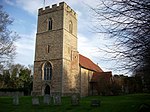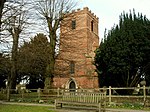Ugley Green

Ugley Green is a small village in the district of Uttlesford in Essex, England. It is approximately 6 miles (10 km) north-east from Bishops Stortford, and just to the west of the M11 motorway. The village is within the civil parish of Ugley, a smaller settlement 1.5 miles (2.4 km) to the north. The village contains two Grade II listed 19th-century houses, and a post-medieval house.The village hall was built in 1920. Occupations in 1933 included four farmers, a carpenter, a stationer & sub-postmaster, a blacksmith, a gravel merchant, a beer retailer, a shopkeeper, a steward to Wades Hall, and the licensee of the White Hart public house. Wades Hall is the remaining wing of a larger house dating to the 16th century, Grade II listed, and approximately 1 mile (1.6 km) northwest from the village.
Excerpt from the Wikipedia article Ugley Green (License: CC BY-SA 3.0, Authors, Images).Ugley Green
Dellows Lane, Uttlesford Ugley
Geographical coordinates (GPS) Address Nearby Places Show on map
Geographical coordinates (GPS)
| Latitude | Longitude |
|---|---|
| N 51.9219 ° | E 0.2155 ° |
Address
Dellows Lane
CM22 6HN Uttlesford, Ugley
England, United Kingdom
Open on Google Maps










